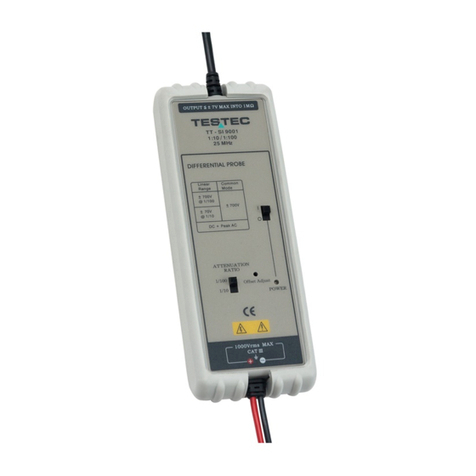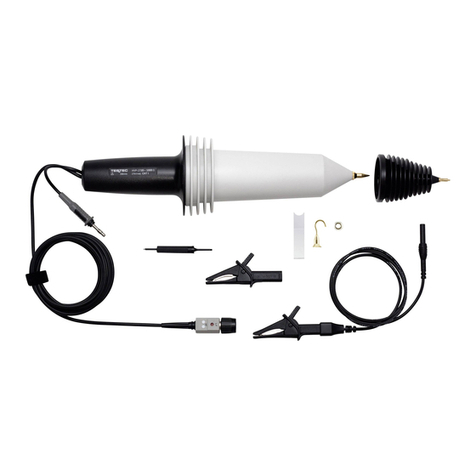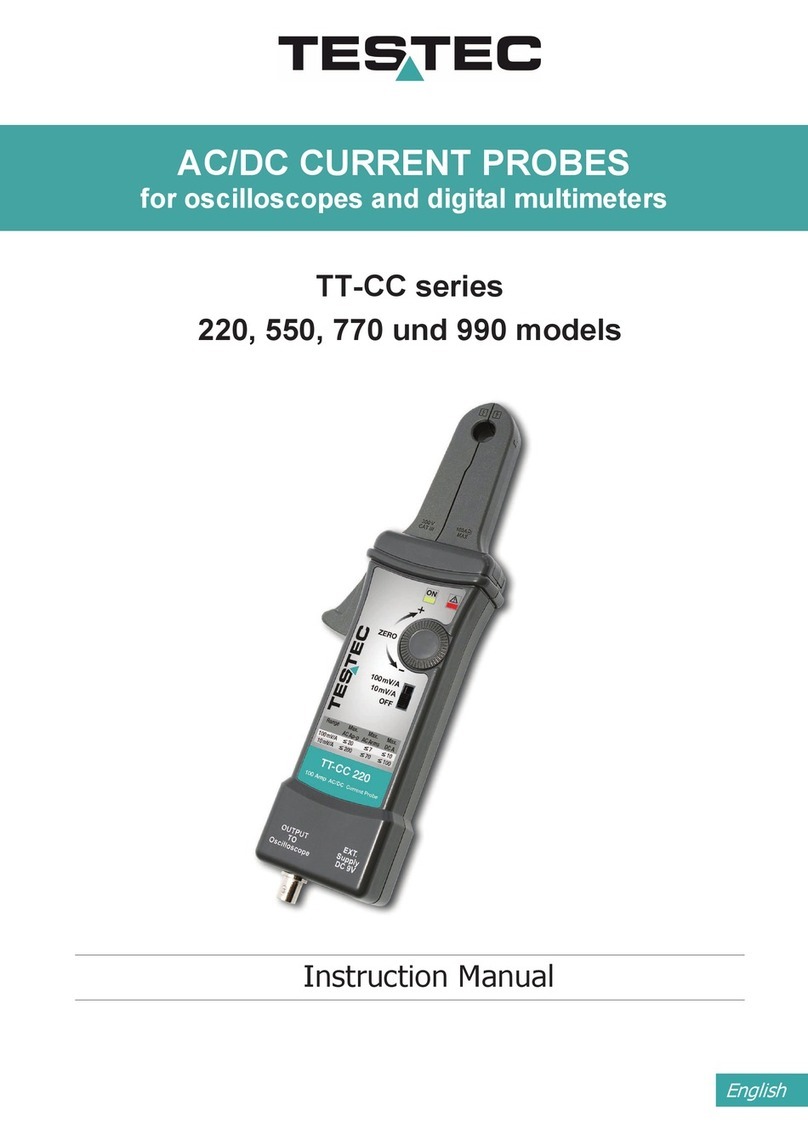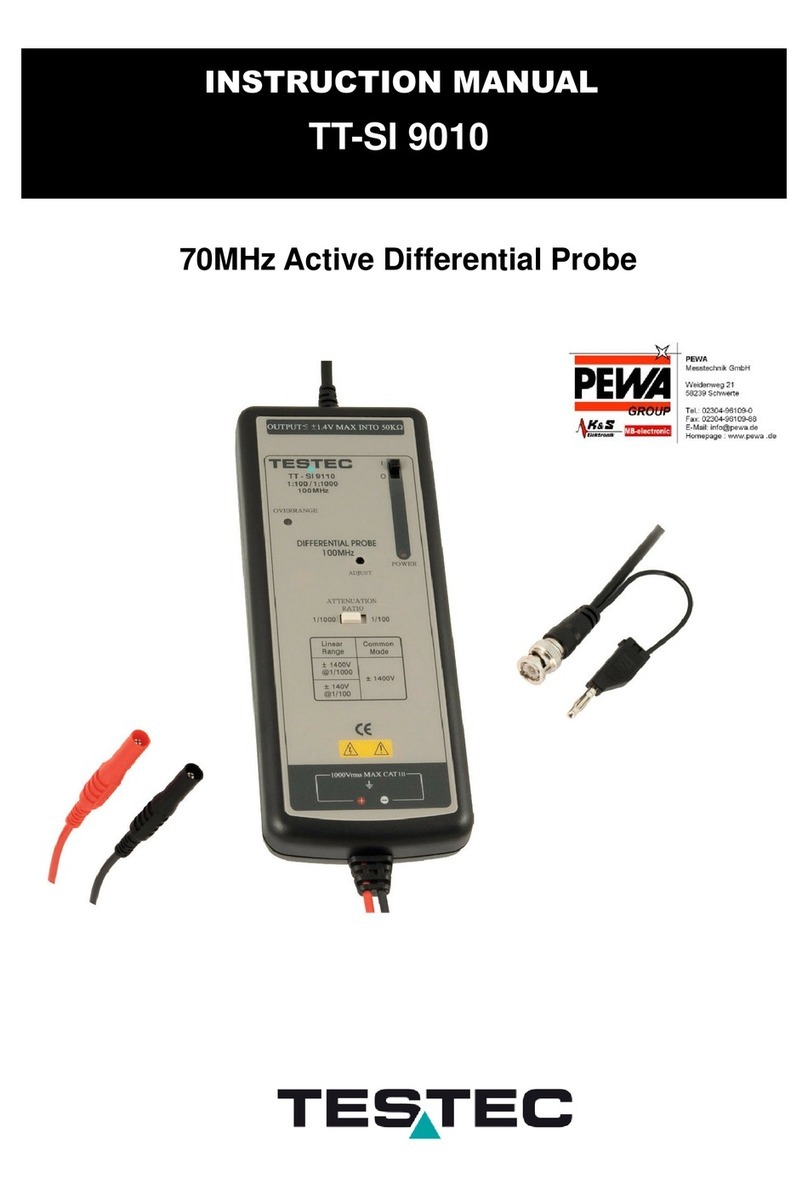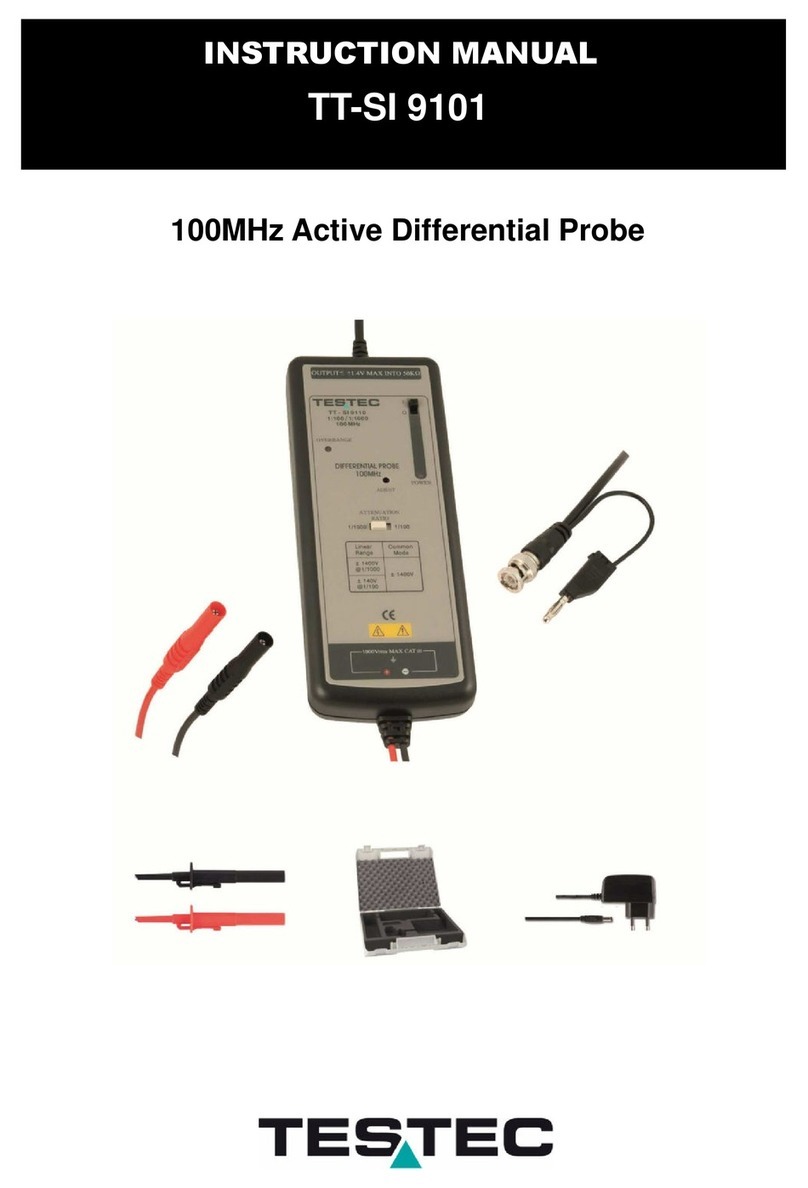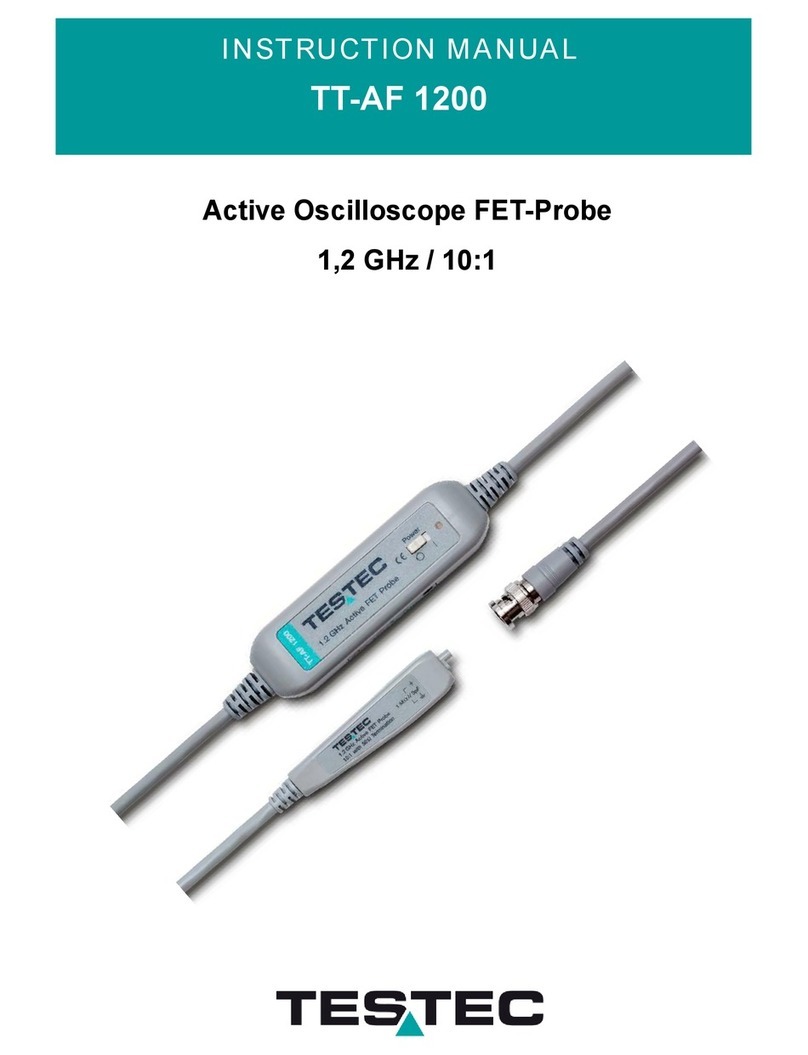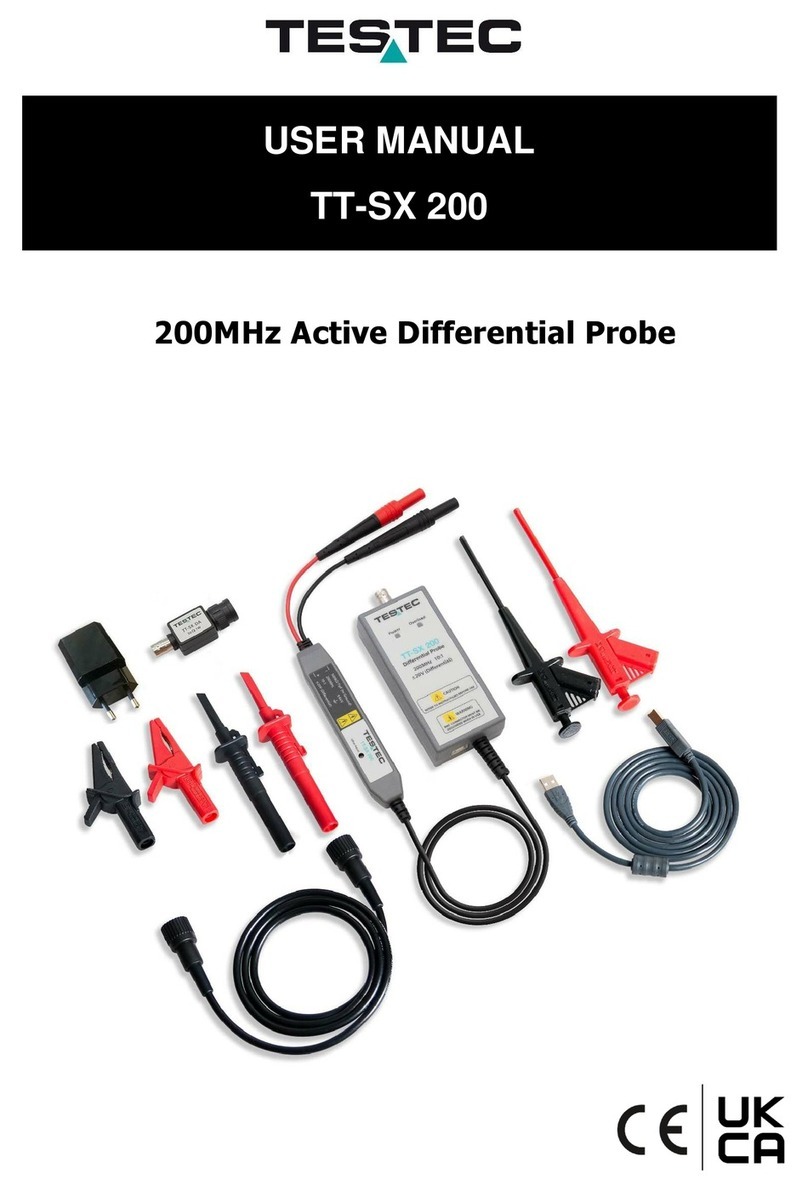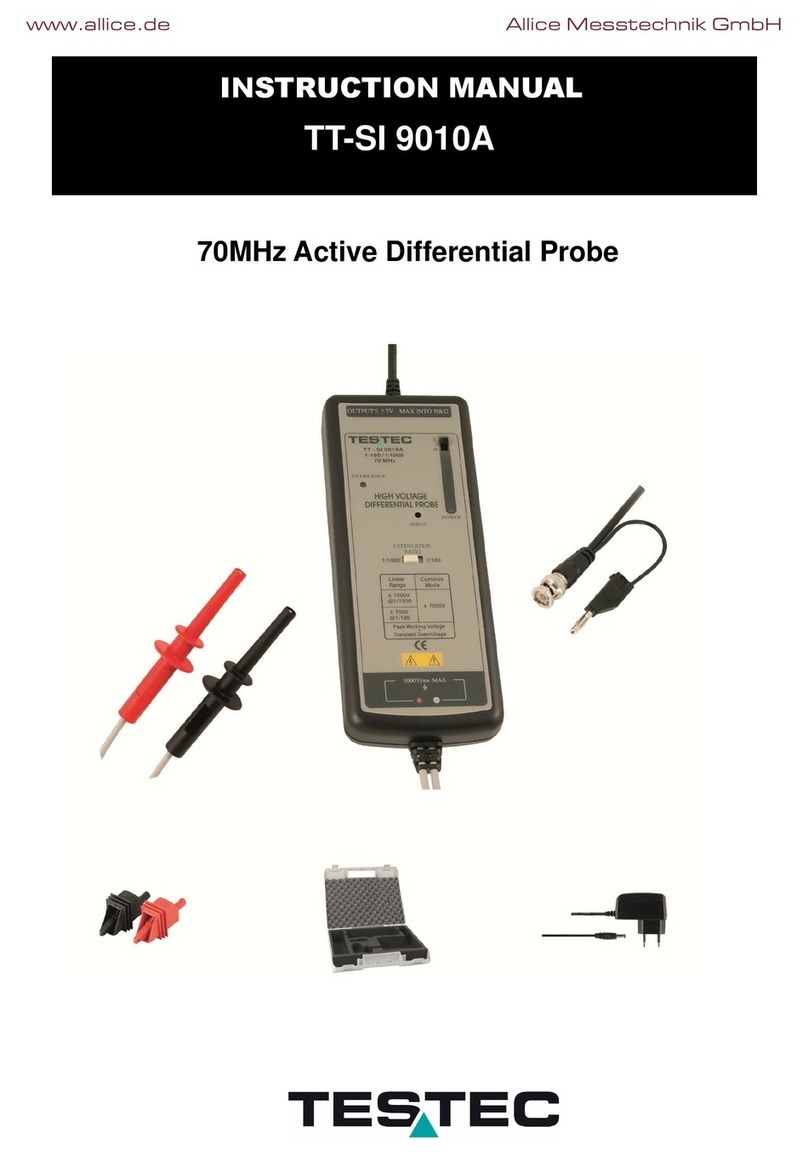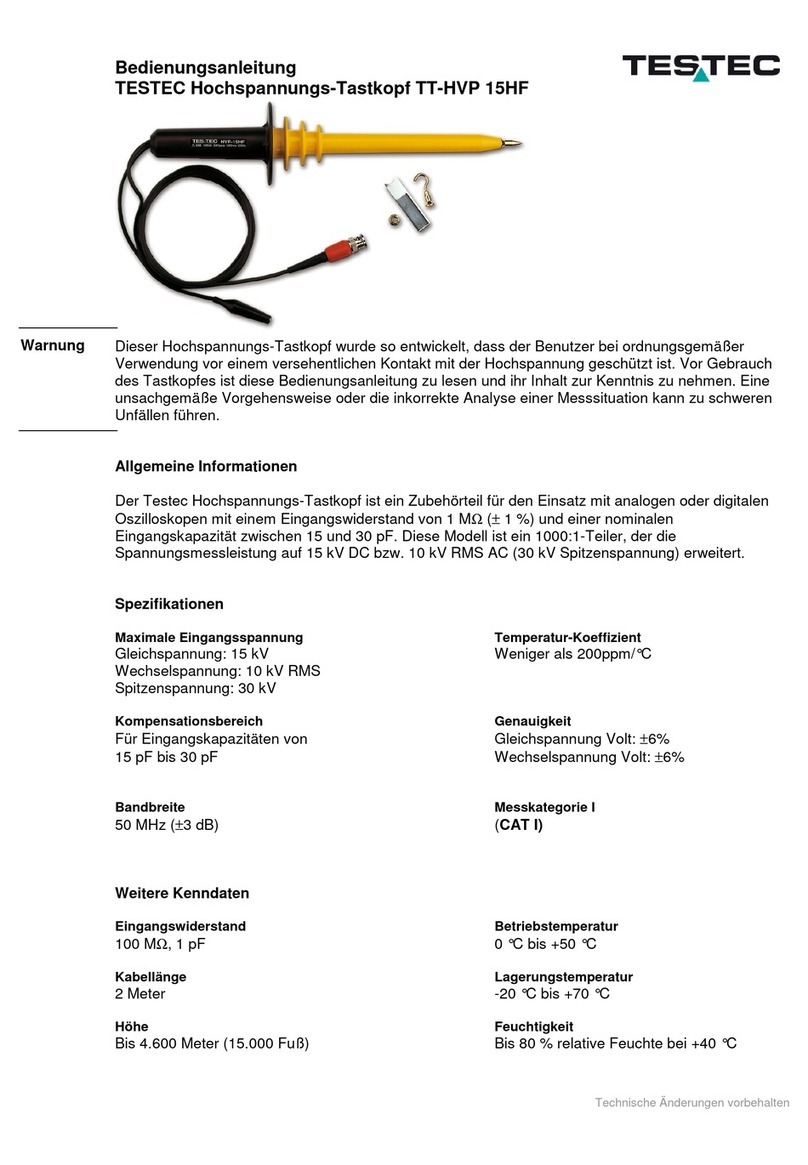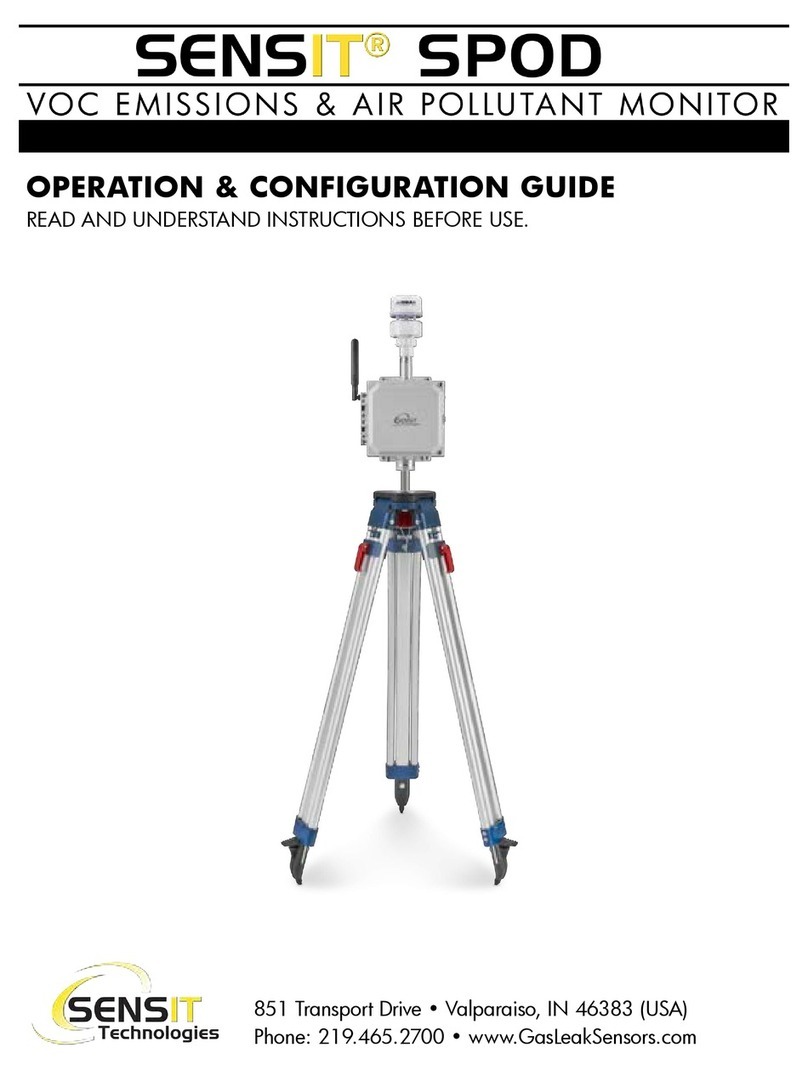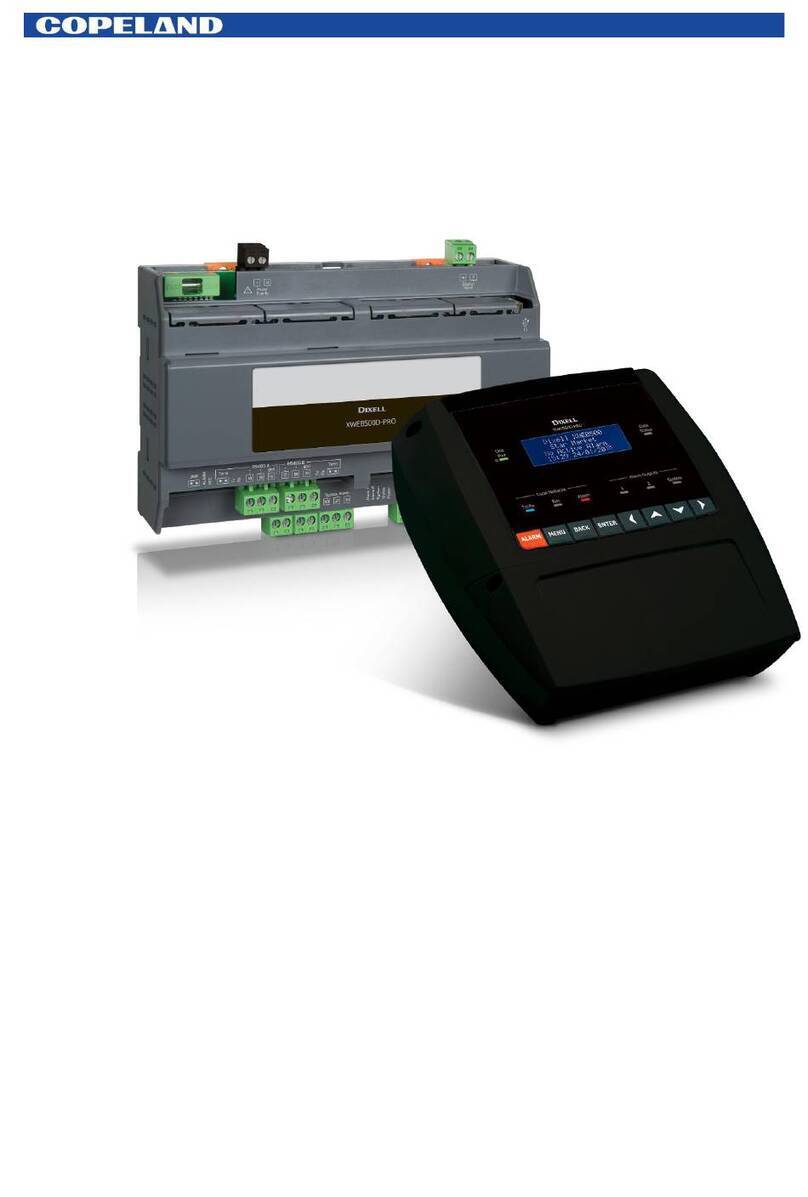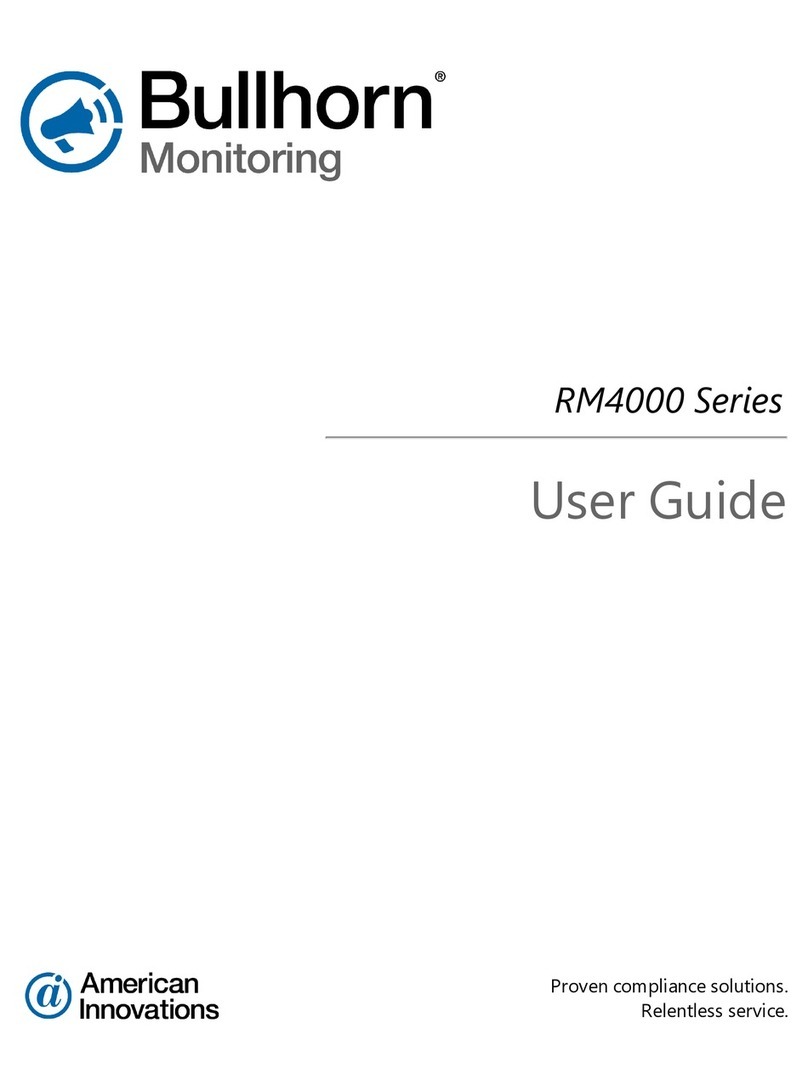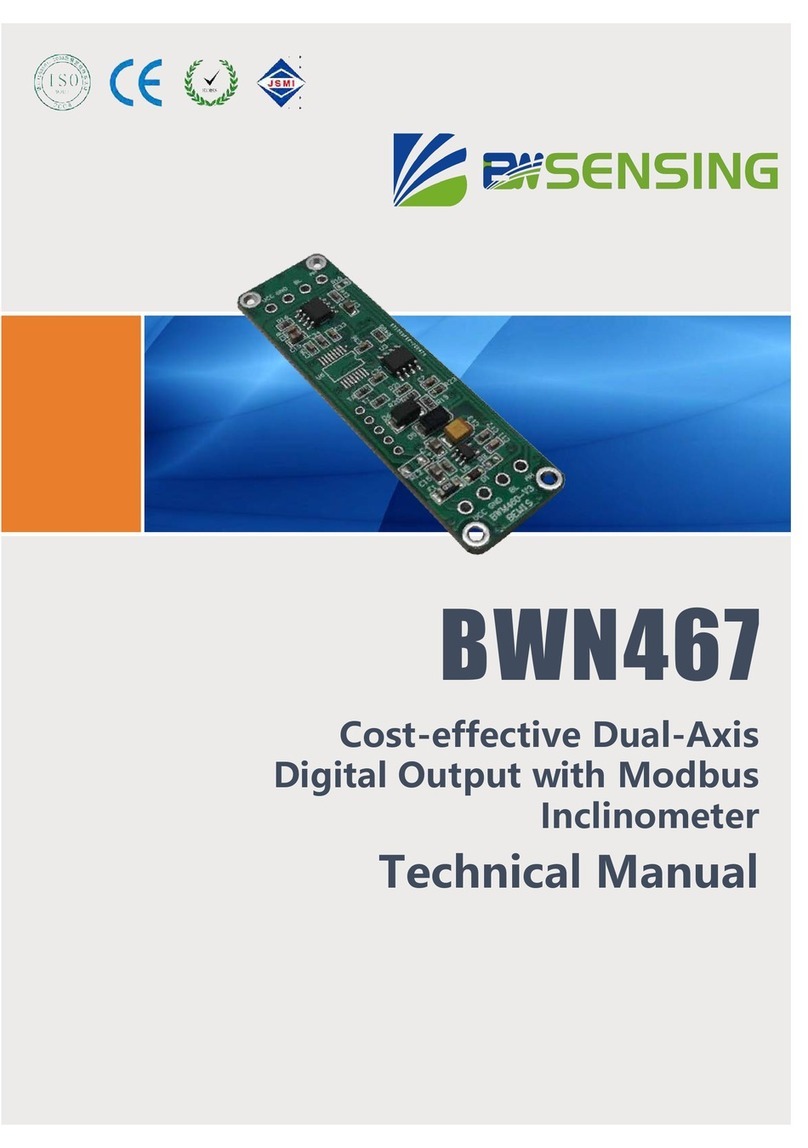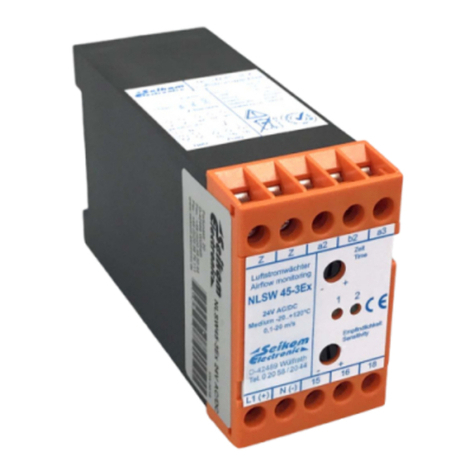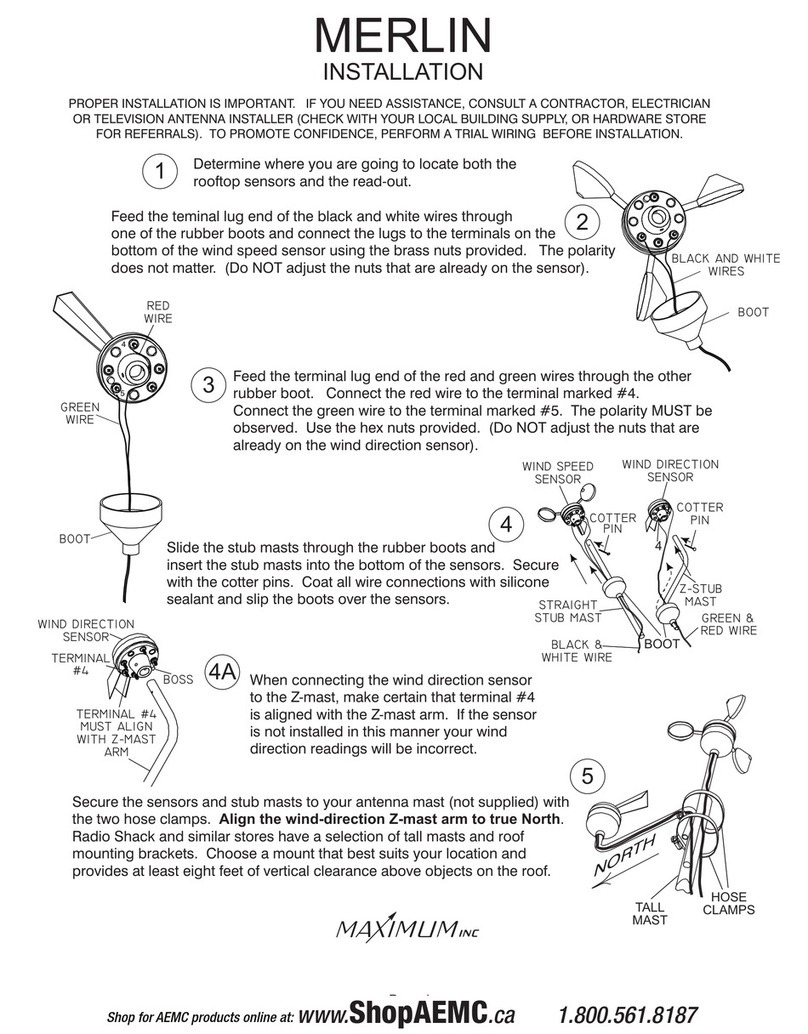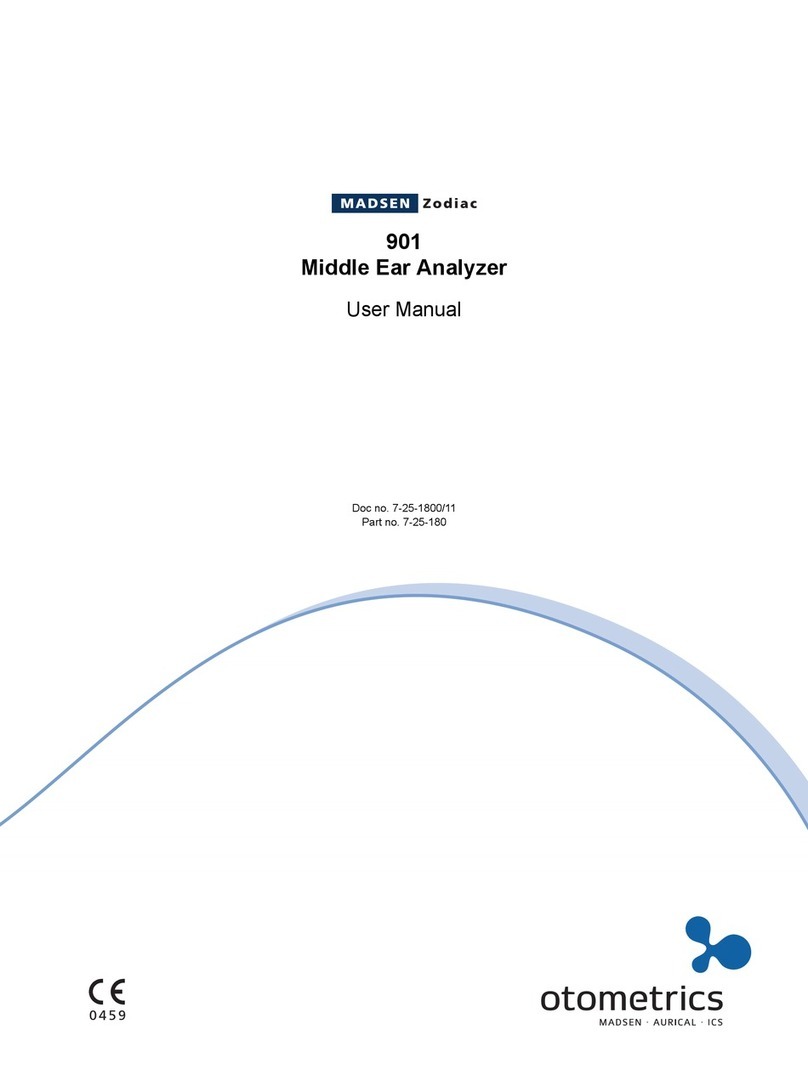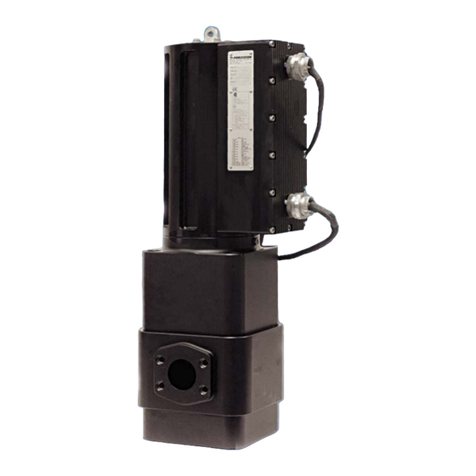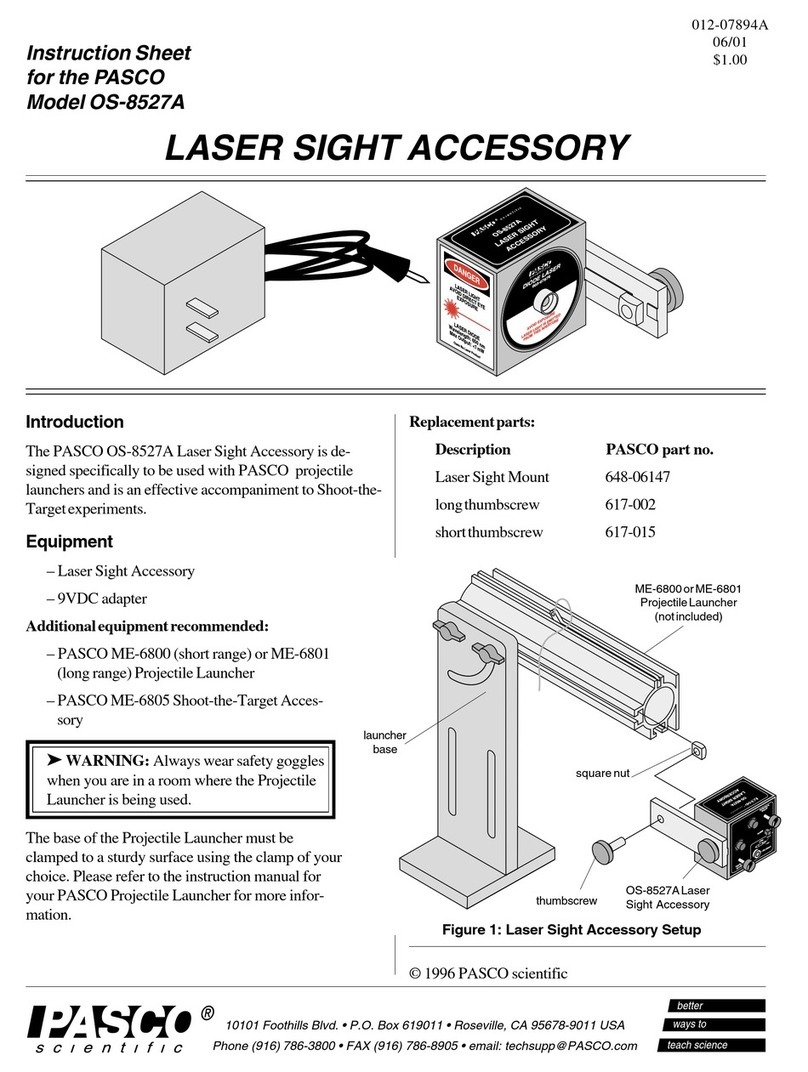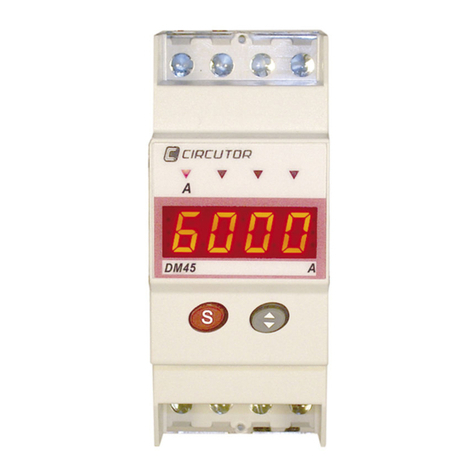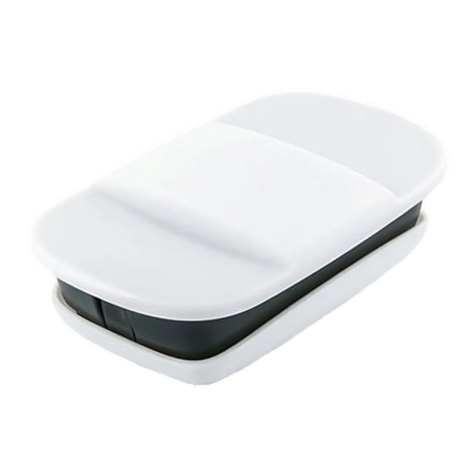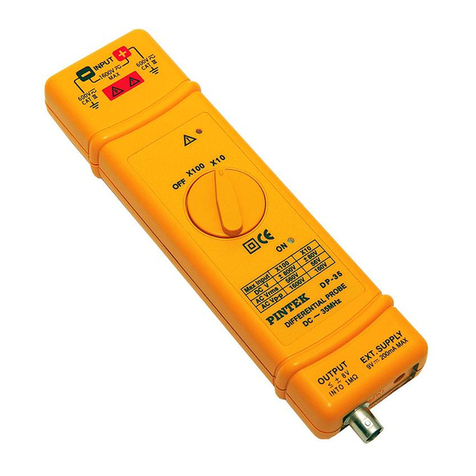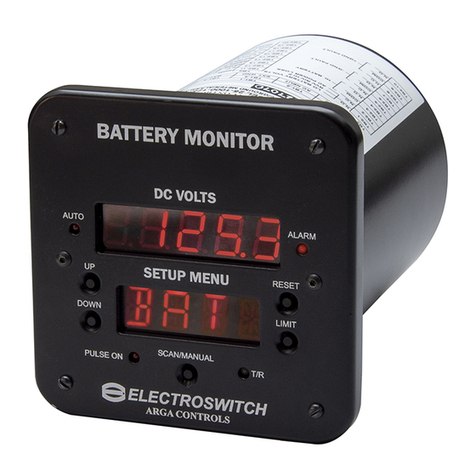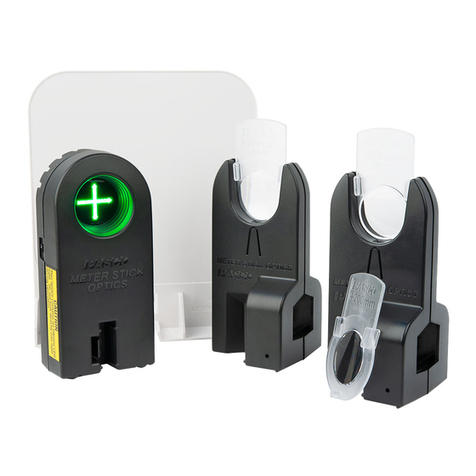
User’s Guide
TESTEC High Voltage Probe TT-HVP 40
This high voltage probe is designed to prevent accidental shock to the operator when properly used.
This operating note must be read and understood prior to using the probe. Improper procedures or
incorrect analysis of the measurement situation can result in serious shock.
General Information
The Testec High Voltage Probe TT HVP 40 is an accessory to be used with analog or digital multimeters
having an input resistance of 10 M Ω(±1 %). The Testec Model TT-HVP 40 is a 1000:1 divider which
extends a voltmeter’s measurement capability to 40 kV dc/ 28 kV rms ac.
Specifications
Maximum Input Voltage CAT I Temperature Coefficient
DC Voltage: 40kV Less than 200ppm/°C
AC Voltage: (0 to 300 Hz) 28 kV RMS
Accuracy Division Ratio Accuracy
DC volts: ±2 % (1 kV to 20 kV) 1000:1 ±1 % when terminated in 10 MΩ
±3 % (20 kV to 40 kV) 2000:1 ±6 % when terminated in 1 MΩ
Other Characteristics
Input Resistance Operating Temperature
1000 MΩ0 °C to +50 °C
Cable Length: Storage Temperature:
1 meter -20 °C to +70 °C
Altitude: Humidity
Up to 4.6000 meters (15.000 ft) Up to 80 % relative humidity at +40 °C
Accuracy
AC Volts: 5 % at 60 Hz
AC output derates with frequency
to -3db at 300 Hz. The graph at the
right shows typical AC accuracy.
Actual AC accuracy varies with the
amount of shunted input capacitance.
Warning
User’s Guide
Agilent Technologies 34136A High Voltage Probe
WA RNI N G This high voltage probe is designed to prevent accidental shock to the operator when properly
used. This operating note must be read and understood prior to using the probe. Improper
procedures or incorrect analysis of the measurement situation can result in serious shock.
General Information
The Agilent Technologies 34136A High Voltage Probe is an accessory to be used with analog or digital
multimeters having an input resistance of 10 M Ω ( ±1%). The Agilent Technologies Model 34136A
is a 1000:1 divider which extends a voltmeter’s measurement capability to
40 kV dc/ 28 kV rms ac.
Specifications
Other Characteristics
AC output derates with frequency to
-3db at 300 Hz. The graph at the right
shows typical AC accuracy.
Actual AC accuracy varies with the
amount of shunted input capacitance.
Maximum Input Voltage Temperature Coefficient
DC Voltage: 40kV
AC Voltage: (0 to 300 Hz) 28 kV RMS
Less than 200ppm/ °C
Accuracy Division Ratio Accuracy
DC volts: ±2% (1 kV to 20 kV)
±3% (20 kV to 40 kV)
1000:1 ±1% when terminated in 10 MΩ
2000:1 ±6% when terminated in 1 MΩ
Pollution Degree 2
Input Resistance Operating Temperature
1000 MΩ 0 °C to +50 °C
Cable Length: Storage Temperature:
1 meter −20 °C to +70 °C
Altitude: Humidity
Up to 4,600 meters (15,000 ft) Up to 80% relative humidity at +40 °C
Accuracy
AC Volts: 5% at 60 Hz
-3
0
Atten
(dB)
Frequency
DC 300 Hz
User’s Guide
TESTEC High Voltage Probe TT-HVP 40
This high voltage probe is designed to prevent accidental shock to the operator when properly used.
This operating note must be read and understood prior to using the probe. Improper procedures or
incorrect analysis of the measurement situation can result in serious shock.
General Information
The Testec High Voltage Probe TT HVP 40 is an accessory to be used with analog or digital multimeters
having an input resistance of 10 M Ω(±1 %). The Testec Model TT-HVP 40 is a 1000:1 divider which
extends a voltmeter’s measurement capability to 40 kV dc/ 28 kV rms ac.
Specifications
Maximum Input Voltage CAT I Temperature Coefficient
DC Voltage: 40kV Less than 200ppm/°C
AC Voltage: (0 to 300 Hz) 28 kV RMS
Accuracy Division Ratio Accuracy
DC volts: ±2 % (1 kV to 20 kV) 1000:1 ±1 % when terminated in 10 MΩ
±3 % (20 kV to 40 kV) 2000:1 ±6 % when terminated in 1 MΩ
Other Characteristics
Input Resistance Operating Temperature
1000 MΩ0 °C to +50 °C
Cable Length: Storage Temperature:
1 meter -20 °C to +70 °C
Altitude: Humidity
Up to 4.6000 meters (15.000 ft) Up to 80 % relative humidity at +40 °C
Accuracy
AC Volts: 5 % at 60 Hz
AC output derates with frequency
to -3db at 300 Hz. The graph at the
right shows typical AC accuracy.
Actual AC accuracy varies with the
amount of shunted input capacitance.
Warning
Sicherheitsvorkehrungen
• Dieser Hochspannungs-Tastkopf darf nur von Personen verwendet werden, die über
entsprechende Ausbildung und/oder Erfahrung verfügen oder die auf Grund einer anderweitigen
Qualifikation in der Lage sind, gefährliche Situationen zu erkennen. Auch muss eine Unterweisung
in den Sicherheitsvorkehrungen erfolgt sein, die befolgt werden müssen, um Unfälle bei der
Verwendung eines solchen Gerätes zu vermeiden.
• Arbeiten Sie bei Umgang mit Hochspannungs-Schaltkreisen niemals allein.
• Untersuchen Sie zu Ihrer eigenen Sicherheit den Tastkopf vor jedem Gebrauch auf Risse sowie
Defekte der Kabelisolation. Werden Defekte festgestellt, darf der Messkopf NICHT verwendet
werden.
• Hände, Schuhe, Boden und Arbeitsplatz müssen trocken und sauber sein. Vermeiden Sie
Messungen in Feuchtigkeit oder anderen Umgebungsbedingungen, die die Sicherheit
beeinträchtigen können.
• Vor dem Anschließen oder Abklemmen des Tastkopfes ist die Hochspannungsquelle
abzuschalten.
• Der Körper des Tastköpfes ist sauber und frei von leitenden Verunreinigungen zu halten. Siehe
auch „Reinigung“.
Verwendung
• Verbinden Sie die Stecker mit den Spannungs- und Masse-Anschlüssen Ihres Voltmeters.
• Wählen Sie die gewünschte Spannung sowie den gewünschten Bereich aus; verwenden Sie nicht
die automatische Bereichswahl.
• Schalten Sie die Hochspannungsquelle ab, wann immer dies möglich ist, bevor Sie Verbindungen
herstellen.
• Verbinden Sie die Masse-Leitung des Tastkopfes (Krokodilklemme) mit einer guten Erdung oder
einer verlässlichen Gehäuseerde.
• Versuchen Sie nicht, Messungen an Quellen durchzuführen, deren Gehäuse oder Rückleitung
nicht geerdet sind.
• Die Erdleitung ist von entscheidender Bedeutung für eine sichere Verwendung des Tastkopfes.
Wird bei Hochspannungs-Messungen versäumt, diesen Anschluss vorzunehmen, so kann dies zu
Personenschäden oder zu Schäden am Tastkopf oder Voltmeter führen. Diese Verbindung ist
immer herzustellen, BEVOR der Kontakt zwischen dem Tastkopf und der Hochspannungsquelle
hergestellt wird. Sie darf erst getrennt werden, wenn der Tastkopf von der Hochspannungsquelle
getrennt wurde.
• Verbinden Sie unter keinen Umständen die Erdleitung mit der Hochspannungsquelle.
• Stellen Sie vor dem Einschalten der Hochspannungsquelle sicher, dass kein Teil Ihres Körpers zu
dieser Kontakt hat.
• Nehmen Sie die Messung vor und bedenken Sie dabei, dass die gemessene Spannung 1000 mal
größer ist als die Anzeige des Voltmeters.
• Schalten Sie die Hochspannung ab.
• Entfernen Sie den Tastkopf von der Hochspannungsquelle, BEVOR Sie die Erdleitung abtrennen.
Reinigung
• Reinigen Sie nur das Äußere von Tastkopf und Kabel. Verwenden Sie dafür ein weiches
Baumwolltuch, sowie eine milde Lösung von Reinigungsmittel in Wasser. Tragen Sie dafür Sorge,
dass keinesfalls ein Teil des Messkopfes in Wasser eingetaucht wird.
• Trocknen Sie den Messkopf gründlich ab, bevor Sie damit beginnen, Spannungsmessungen
vorzunehmen.
• Setzen Sie den Messkopf niemals Lösungsmitteln oder Lösungsmitteldämpfen aus, denn diese
können eine Schädigung des Gerätekörpers sowie der Kabel verursachen.
TESTEC Elektronik GmbH Tel.: +49-(0)69-943335-0
Bornheimer Landstr. 32-34 Fax: +49-(0)69-94333555
D-60316 Frankfurt Internet: www.testec.de
Warnung
TESTEC Elektronik GmbH
Westerbachstr. 58
D-60489 Frankfurt
Tel.: +49-(0)69-943335-0
Fax: +49-(0)69-94333555
Internet: www.testec.de


